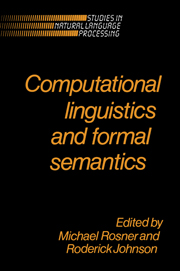Book contents
- Frontmatter
- Contents
- List of contributors
- Preface
- 1 Unification
- 2 Representations and interpretations
- 3 Syntactic categories and semantic type
- 4 Fine-structure in categorial semantics
- 5 Properties, propositions and semantic theory
- 6 Algorithms for semantic interpretation
- 7 Situation schemata and linguistic representation
- 8 Application-oriented computational semantics
- 9 Form and content in semantics
- 10 Epilogue: on the relation between computational linguistics and formal semantics
- Bibliography
10 - Epilogue: on the relation between computational linguistics and formal semantics
Published online by Cambridge University Press: 05 June 2012
- Frontmatter
- Contents
- List of contributors
- Preface
- 1 Unification
- 2 Representations and interpretations
- 3 Syntactic categories and semantic type
- 4 Fine-structure in categorial semantics
- 5 Properties, propositions and semantic theory
- 6 Algorithms for semantic interpretation
- 7 Situation schemata and linguistic representation
- 8 Application-oriented computational semantics
- 9 Form and content in semantics
- 10 Epilogue: on the relation between computational linguistics and formal semantics
- Bibliography
Summary
RELATING THE DISCIPLINES
My role in the original workshop which gave rise to this book was to sum up what had been said during the week, trying to relate the different contributions one to another. In preparing for what threatened to be an arduous task, it occurred to me that a fundamental assumption underlying the organization of such a workshop needed to be taken out and examined overtly: calling a workshop ‘Computational Linguistics and Formal Semantics’ assumes that these two areas of academic endeavour have something to say to each other; may, even, be inextricably related.
Superficially, of course, this seems likely to be true: an investigation of language and its use could be seen as the core interest of both disciplines. But, on looking a little more closely, the intimate connection tends to evaporate. For most computational linguists, the task is to define and implement an adequate treatment of (some subset of) some natural language within the framework of a computer application. Even when they are primarily interested in demonstrating that a particular linguistic theory or a particular paradigm of computation is superior to its rivals, the argument will frequently be couched in application-oriented terms: such and such a theory is superior because it leads to clearer linguistic descriptions which are easier to modify and to debug, for example, or such and such a computational paradigm is superior because it allows linguistic programmers to compartmentalize their knowledge of a language, describing sub-parts independently without having to worry about all the possible intricate complexities of interactions between them.
Information
- Type
- Chapter
- Information
- Computational Linguistics and Formal Semantics , pp. 283 - 300Publisher: Cambridge University PressPrint publication year: 1992
Accessibility standard: Unknown
Why this information is here
This section outlines the accessibility features of this content - including support for screen readers, full keyboard navigation and high-contrast display options. This may not be relevant for you.Accessibility Information
- 1
- Cited by
